Nourishing Sourdough Bread with Red Fife Flour
This post may contain affiliate links. Please read my disclosure policy.
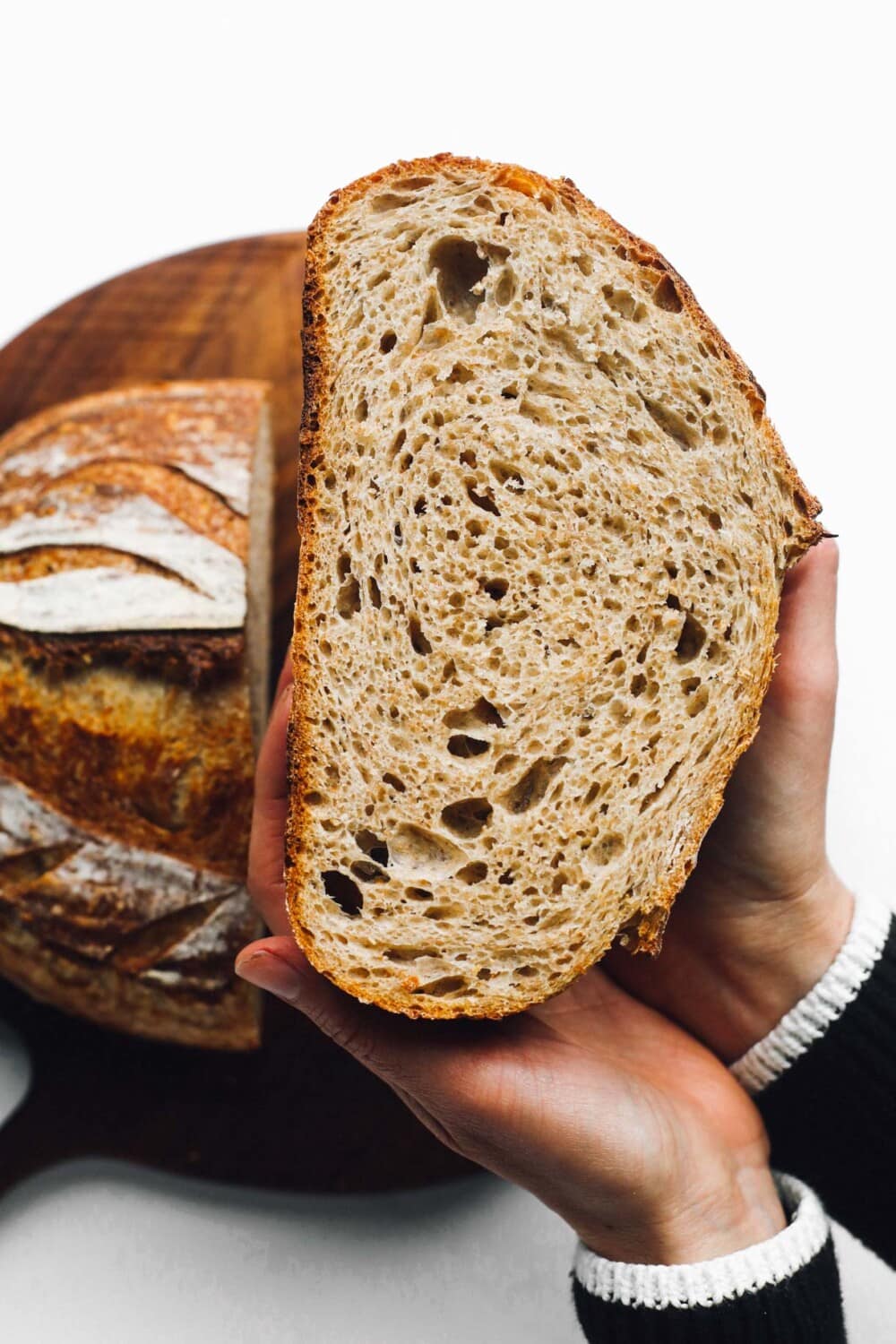
If you’re new to sourdough, and are looking for a sourdough starter to begin, I ship my 13+ year old organic starter to anyone in the U.S! You can order it here.
I’ve fallen hard for this rustic loaf of sourdough bread made with red fife flour, a heritage wheat that leads to fantastic flavor without taking away from the texture. A tender interior with small, porous holes, and a crispy crust that breaks the silence in all its glory when cut.
Using whole grains in sourdough baking:
Whole grain flours keep every part of their seed architecture (bran, germ, endosperm) throughout the milling process. That means fiber, micronutrients, nutrition, flavor. These are great things for health, but they can prove a little bit tricky for baking, namely the fiber in the bran, which will interfere with carbon dioxide production in the dough and compromise rise. They tend to have a lower gluten content as well, which affects their ability to gain dough strength.
Using whole grains in homemade sourdough bread baking takes a bit of practice and experimenting, but the results are soooo flavorful. My go-to brand on whole grain flours are from Flourist. I’ve been experimenting with everything from spelt, rye sourdough, and einkorn.
What kind of wheat is red fife?
Flourist’s Sifted Red Fife Flour is milled from organically grown Red Fife wheat from Vonda, Saskatchewan. This flour is ideal for baking, and is more flavorful and nutritious than grocery store all-purpose flour. I love the honey overtones and nuttiness that it gives to bread.
While still high in protein, the gluten in red fife is slower to develop and is therefore more resilient to over-mixing, which commonly results in tough muffins and cakes.
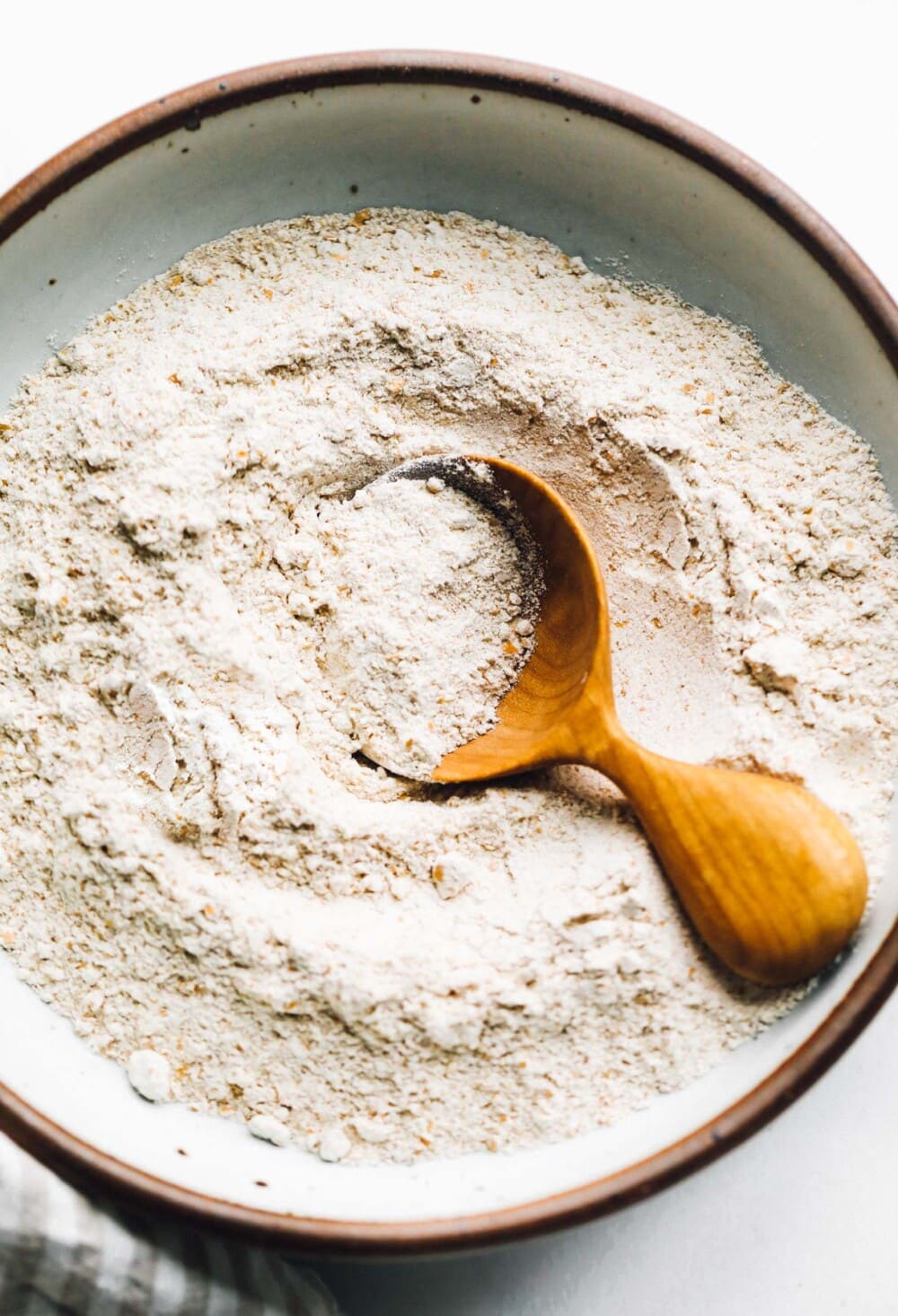
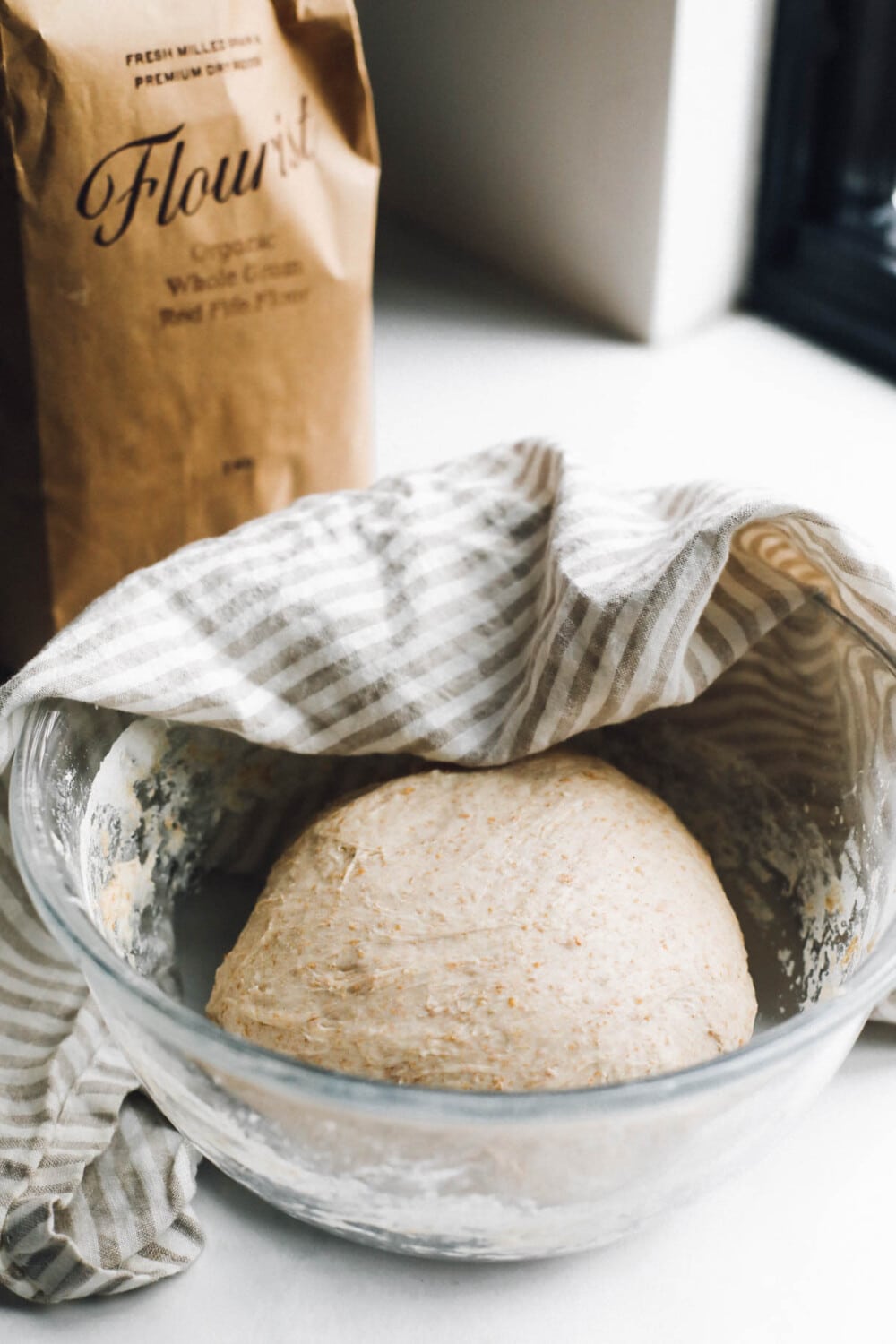
Steps for Whole Grain Sourdough Bread
To keep this homemade sourdough bread soft on the inside and workable, the hydration is moderate. It will be a bit stickier than a loaf made with all bread flour, like my Everyday Sourdough recipe, but just trust it. You’ll need to build strength in the initial stages of bulk fermentation, incorporating a few sets of stretch and folds. This technique helps develop the gluten and helps it hold its shape later on in the process.
Once the bulk fermentation, you’ll shape the dough using this method. Then you can put the dough in the refrigerator for a cold proof final rise overnight, making things very easy. The next morning just score the dough and bake!
This long, slow rise yields a traditional sourdough taste that I’ve been after for quite some time, a sweet tang with its own unique flavor.
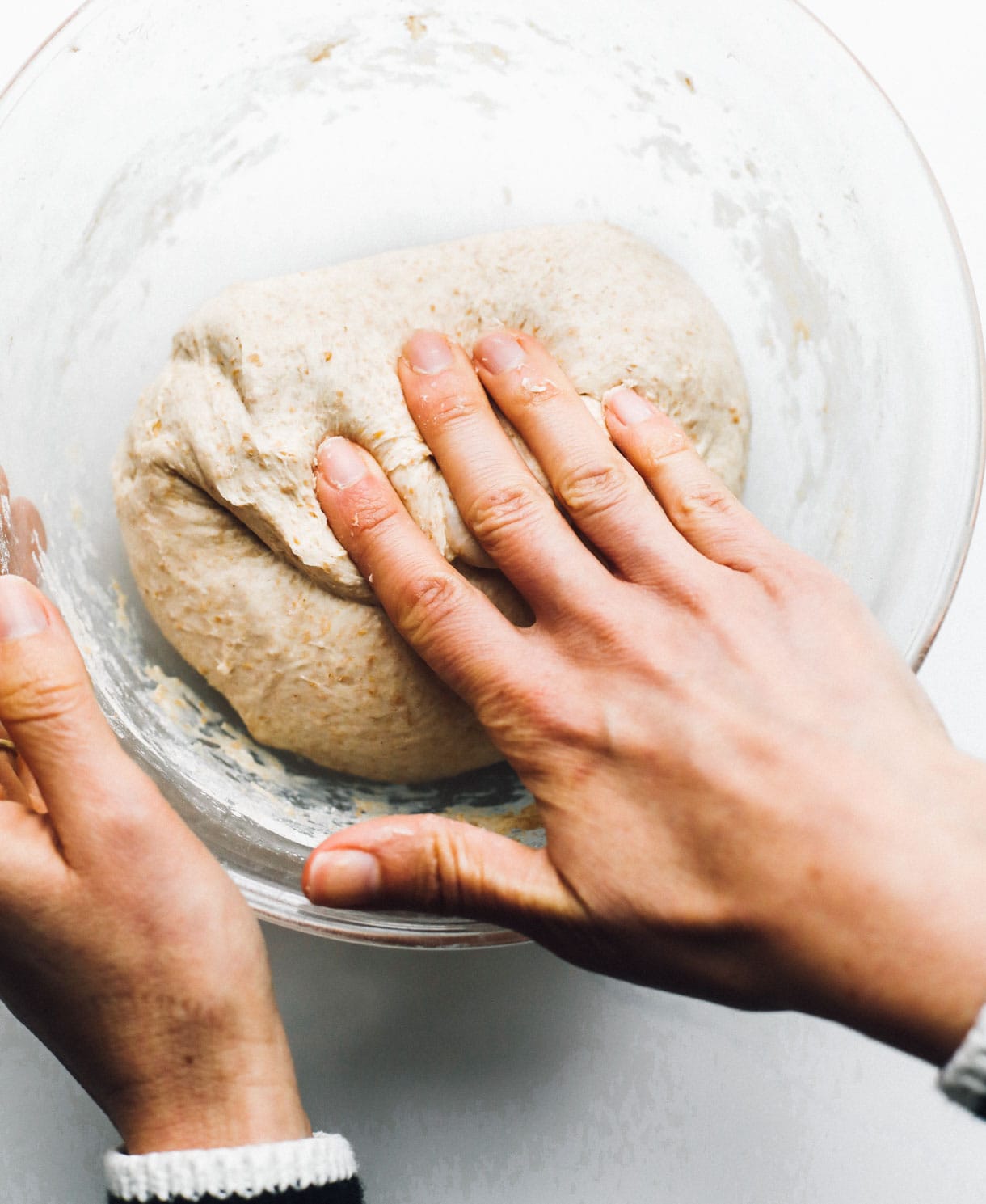
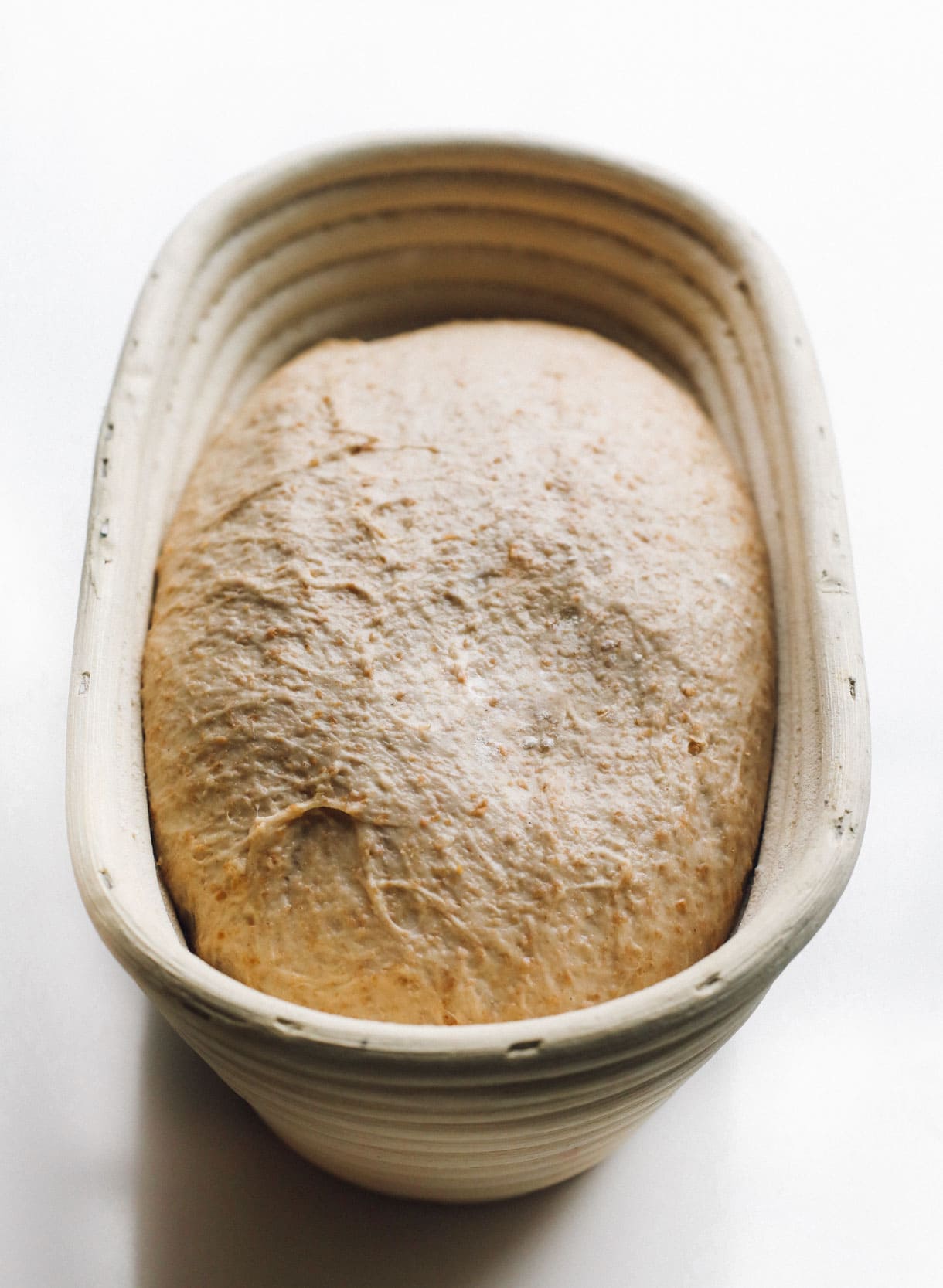
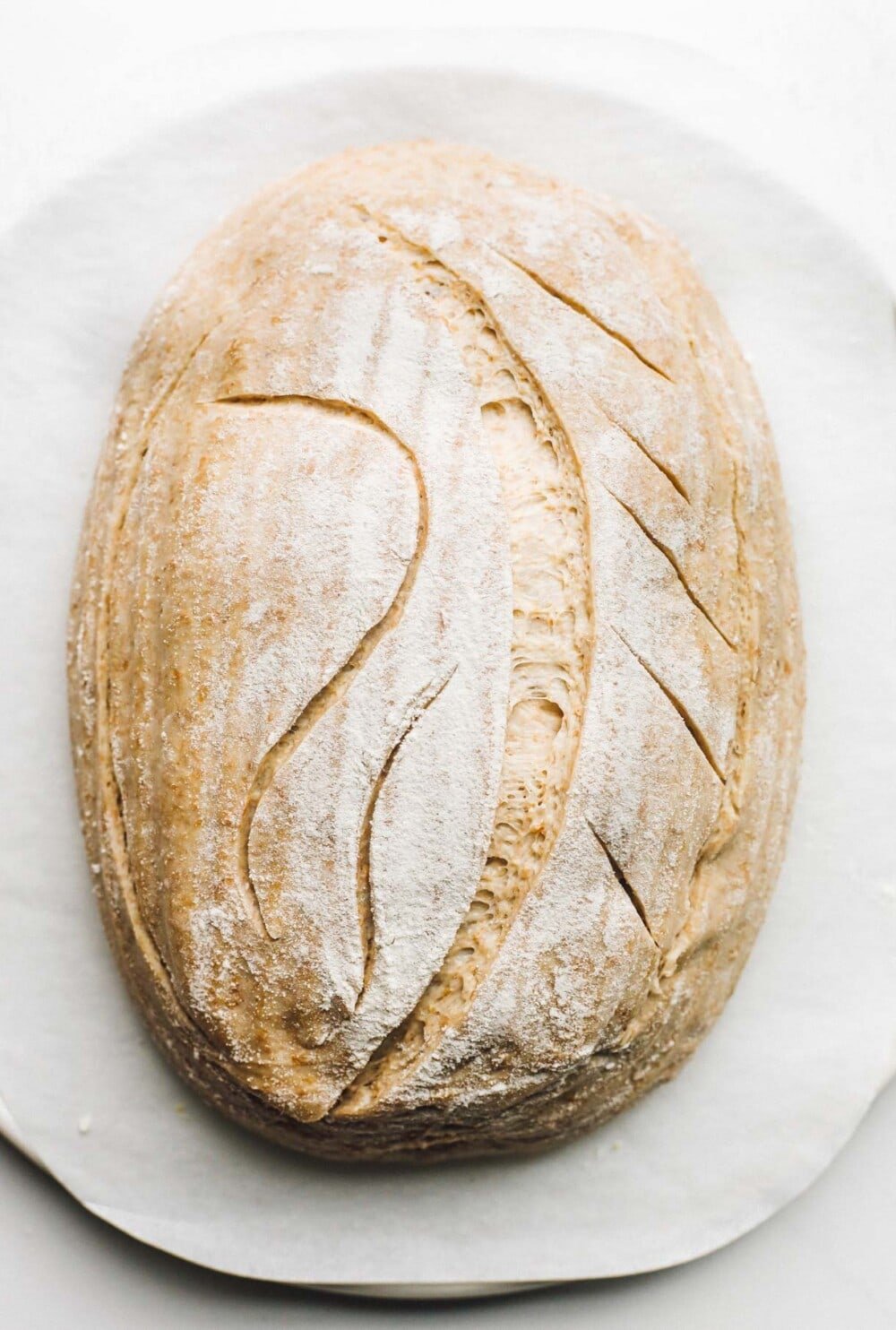
Out of the oven this bread has a crackly crust with rustic fissures with golden brown undertones. The perfect balance between a tender interior and a beautiful lacy crumb (sometimes difficult to achieve with whole grains).
What is the best kind of pan to bake sourdough in?
Using a covered vessel is important for baking sourdough because you need a hot, steamy environment for the bread to rise in before the crust is formed. If there is no steam, the crust will form before the bread has a chance to rise, resulting in a short, dense loaf.
I swear by the Challenger Bread Pan, which I’ve been baking with for 3 years. Before that, I used a 5qt Le Creuset Dutch Oven because I already had one, but once I started baking sourdough every few days, I knew it was a hobby here to stay and I wanted something specifically for bread baking.
The Challenger is actually cheaper than a Le Creuset and here’s why I think it’s superior for sourdough bread baking:
- I’ve never had better oven spring or thinner crusts.
- The shallow base makes loading your dough safe and simplel instead of having to worry about burning yourself when you lower your dough into a hot dutch oven.
- The top handles make it easy remove the cover mid-bake.
- It’s unique shape that allows you to bake any shape of bread in it! Bâtards, boules, demi-baguettes, and other loaves of almost any size.
- Because of how it’s made, the perfect amount of steam is created inside the pan.
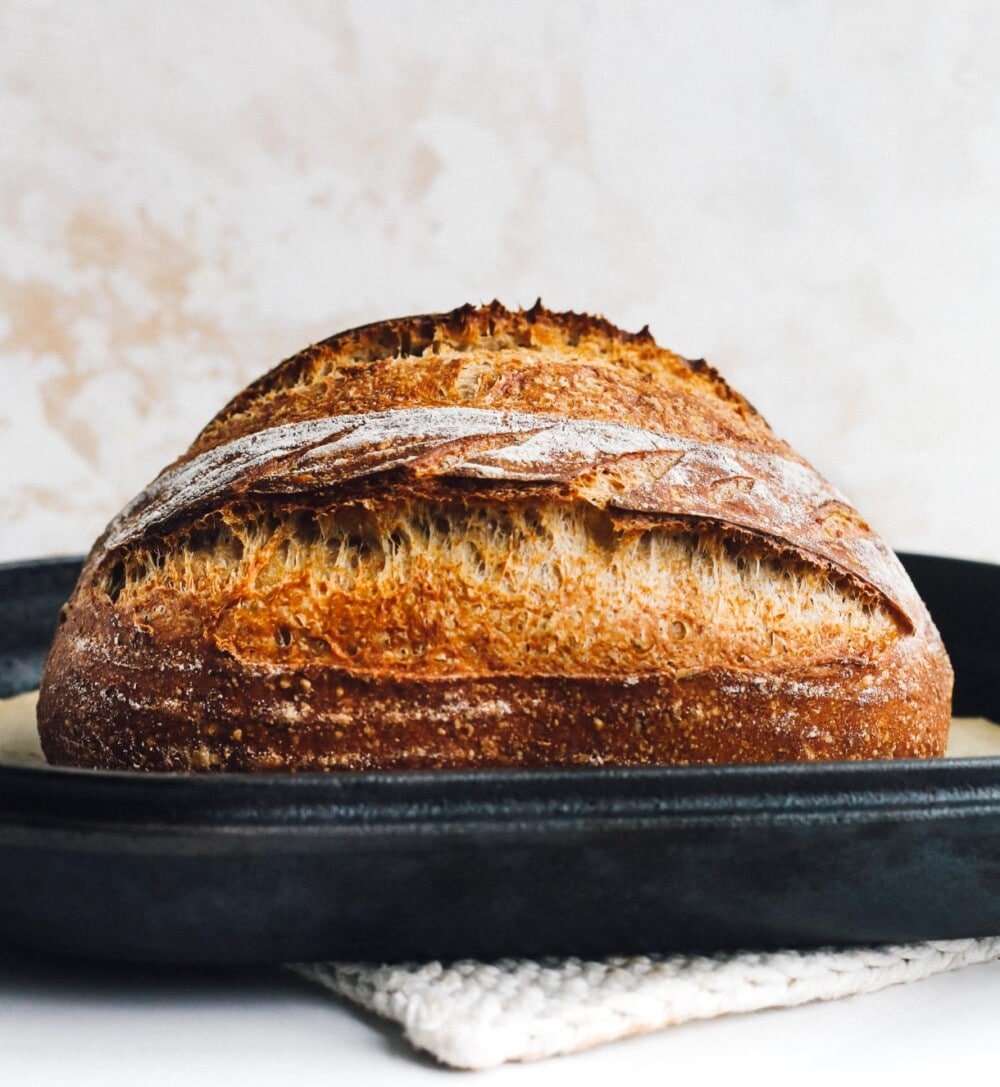
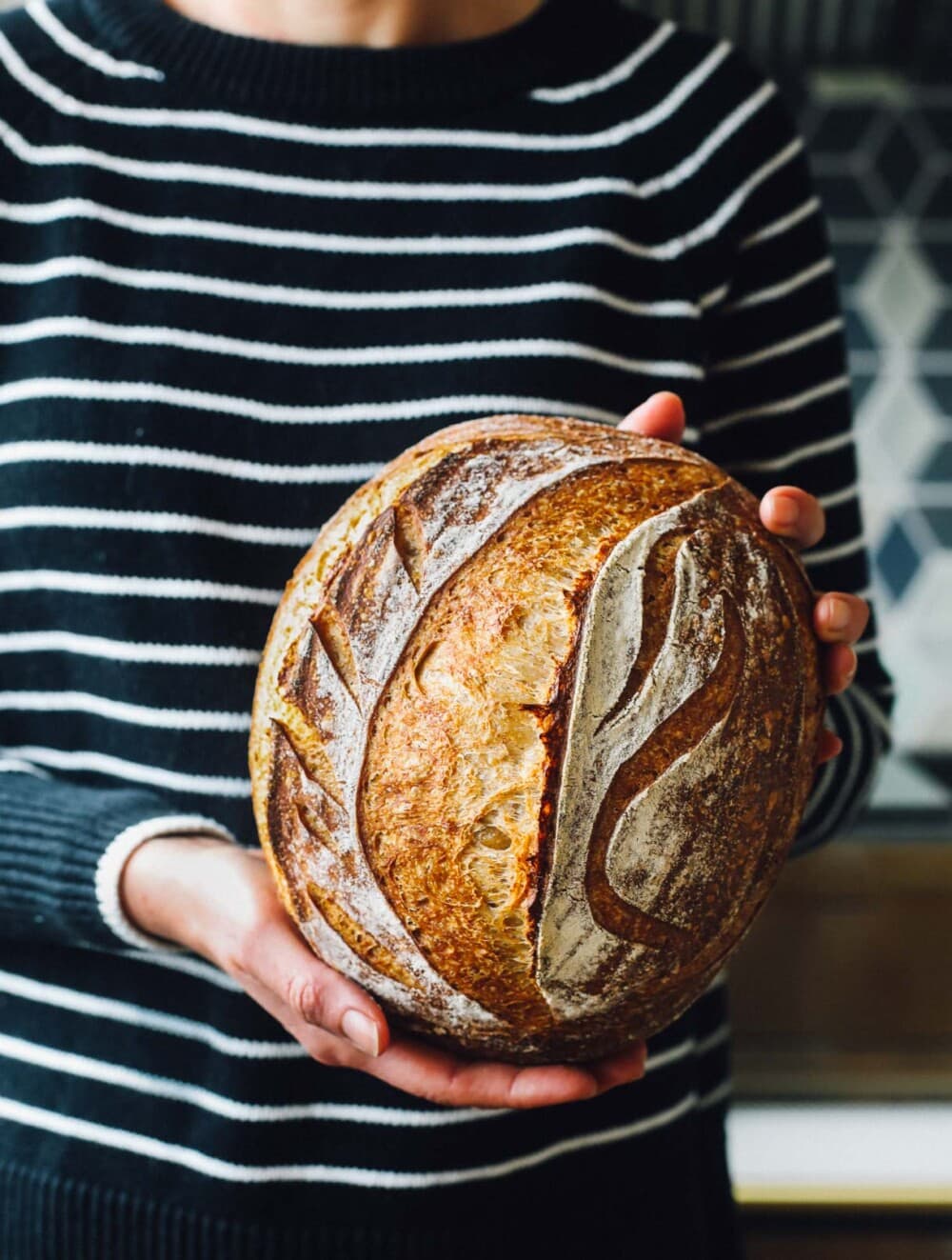
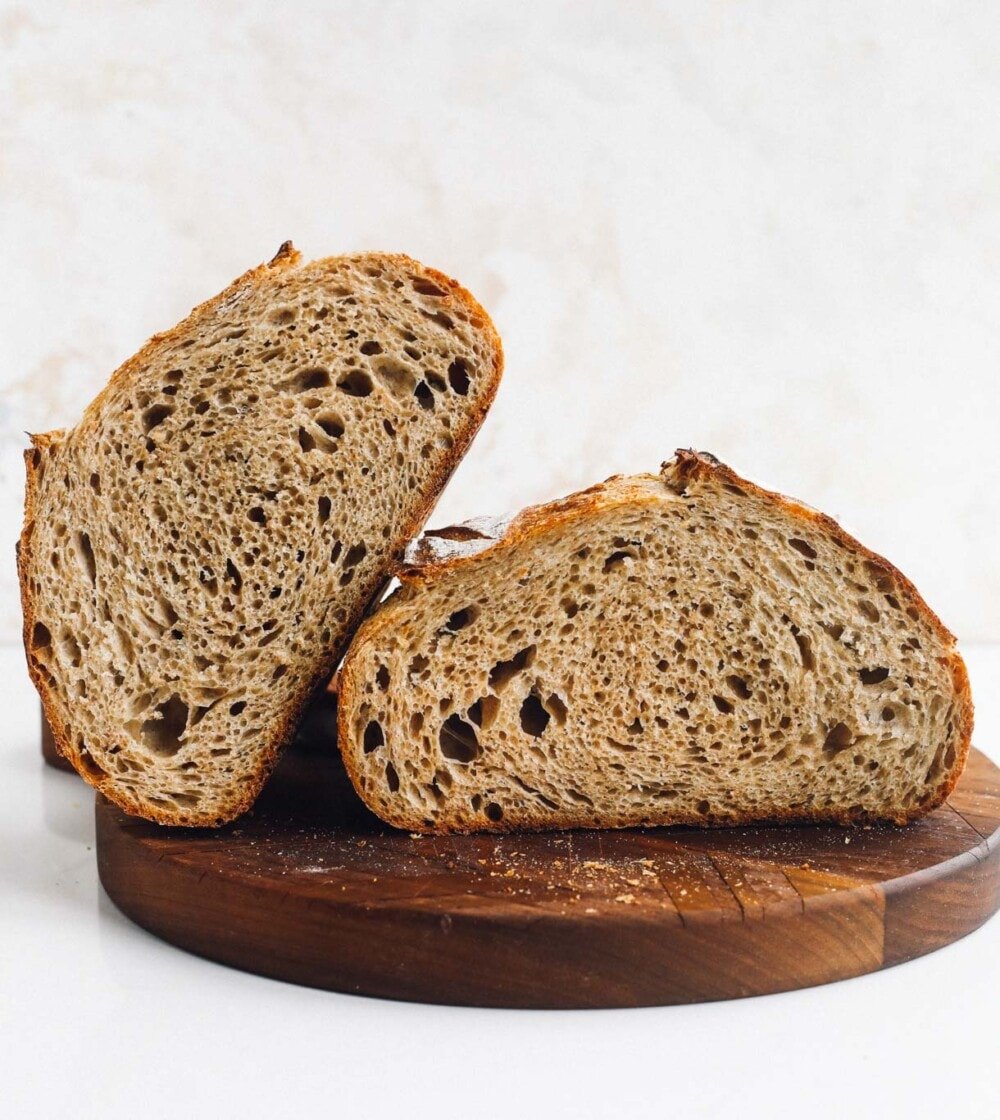
More Sourdough Recipes:
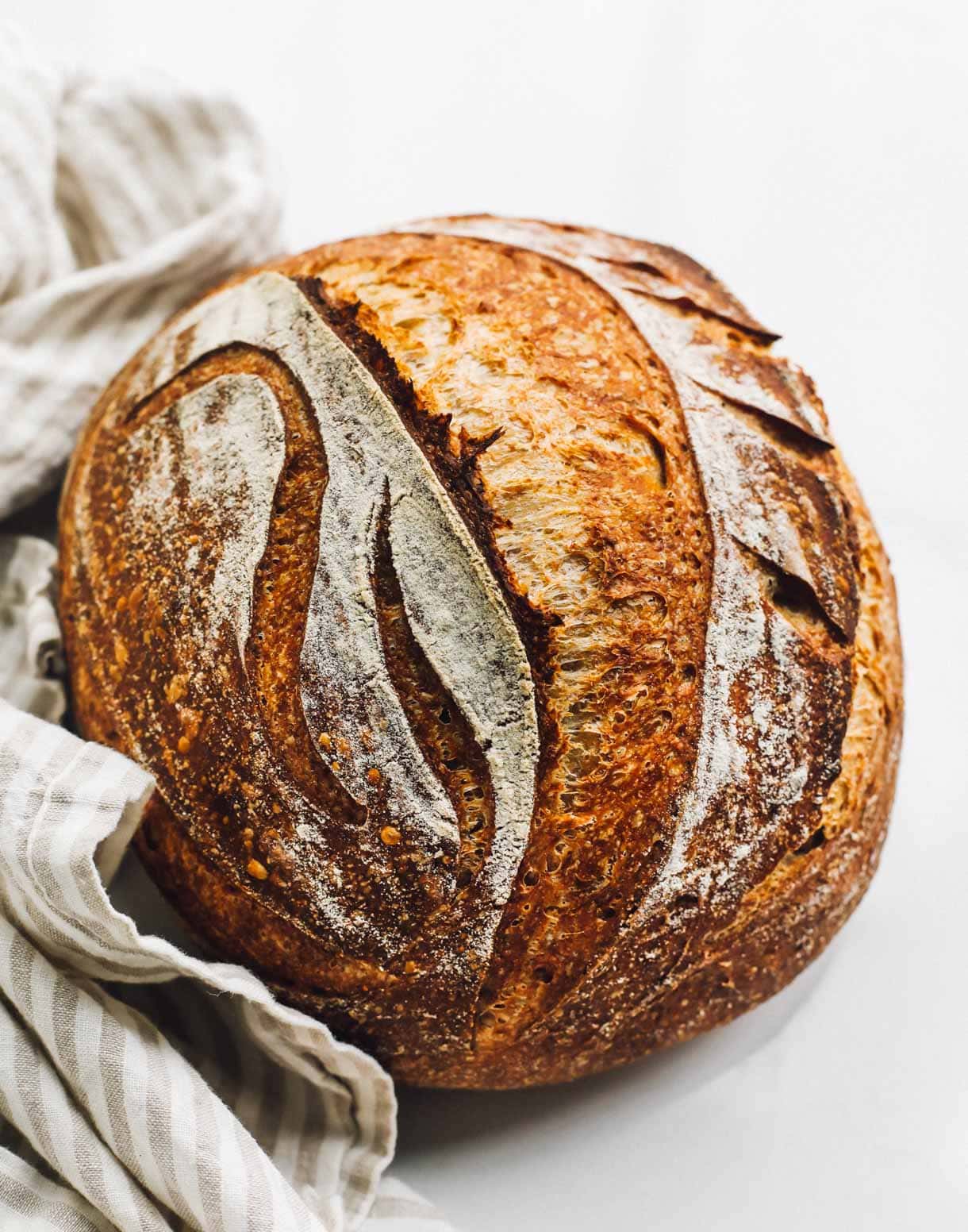
SCALE:
Ingredients
- 50 grams active sourdough starter, at its peak
- 320 grams water, a little warmer than room temperature (about 80 degrees F)
- 230 grams organic bread flour
- 200 grams whole grain red fife flour
- 9 grams fine sea salt
Equipment
Instructions
- Mix starter and water with a fork until distributed. Add flours. Mix with fork until dry, then finish incorporating flours with hands until no flour streaks remain.
- Let rest, covered with a damp cloth, for 45 minutes. This is the autolyse stage.
- When autolyse is complete, add salt and squeeze liberally into dough. Mix dough with your hands for 3 minutes, kneading and really working the salt into the dough. Then perform your first set of stretch and folds. Let rest for 30 minutes, and repeat set of stretch and folds. Do this 2 more times, for a total of 4 sets of stretch and folds.
- When that is finished, let dough rest, cover bowl with a damp cloth and let dough rise until just about doubled, but not quite. You will see some small bubbles around the edges of the top of the dough, and it will be a bit domed, and tiny bubbles all throughout the inside of the dough when you look at the sides of the bowl. This is when bulk fermentation is complete. With my house at 70 degrees F, this took about 4 hours from the last set of stretch and folds.
- Gently move dough onto a lightly floured surface. Let rest for 15 minutes, covered. Then shape your bread and use a bench scraper to put dough into banneton, seam side up. and put into a banneton. (You can use an oval or round banneton.)
- Cover with a plastic bag, and refrigerate for 8-12 hours. The longer it stays in the refrigerator, the more tang (sour) you will get from the loaf.
- Preheat oven to 450 degrees F, with your dutch oven in it. When oven is preheat, remove dough from refrigerator and score according to your preference. Bake for 20 minutes with lid on, then remove lid and turn heat down to 425 degrees F and bake for additional 20-25 minutes, until crust is golden brown.
- Remove from oven and place on cooling rack. Let rest for one hour before slicing.
Did you make this?
tag @heartbeetkitchen on instagram and hashtag it #heartbeetkitchen

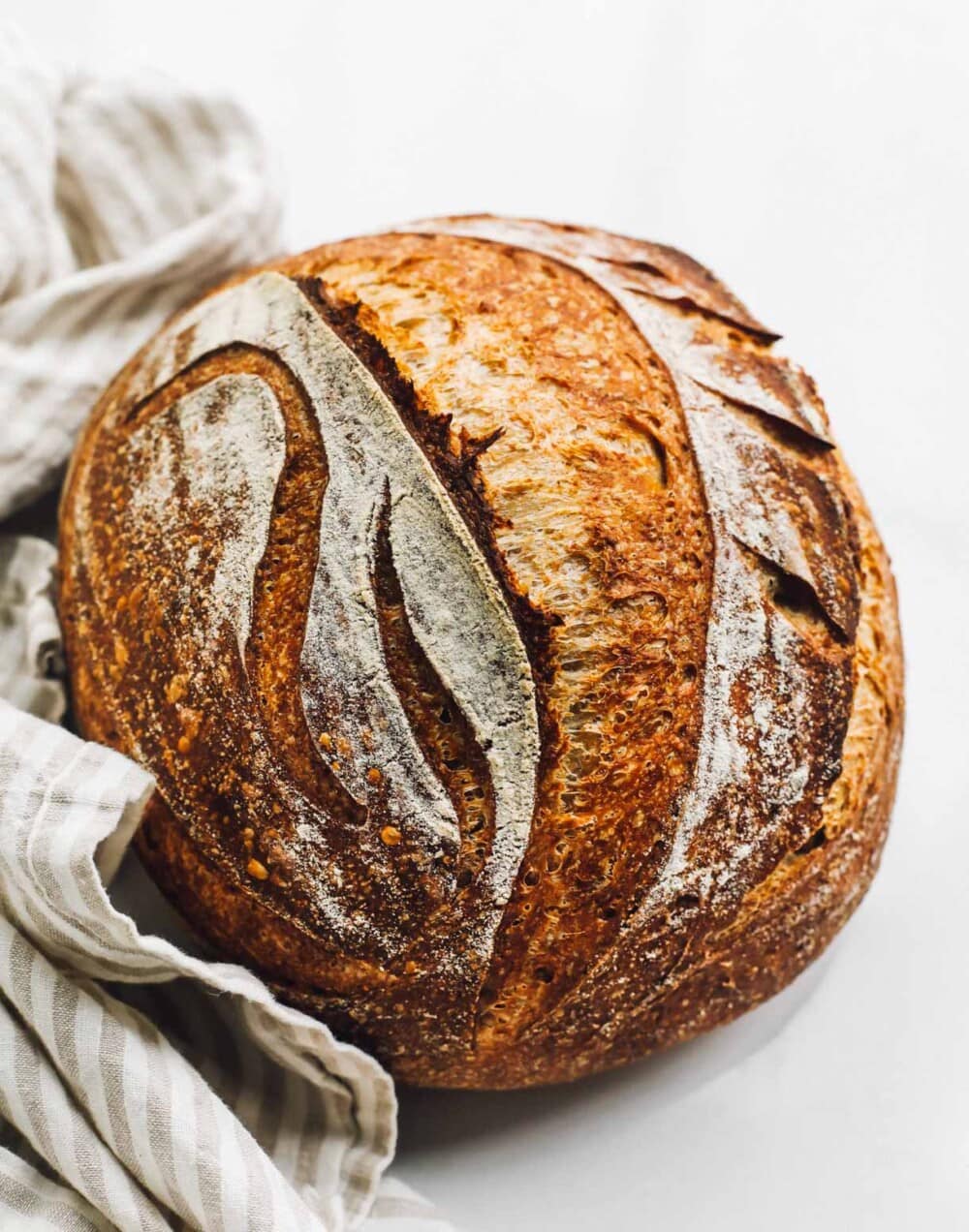

Jim
May 20, 2023
Just made my first loaf of red fife sourdough. It was very good with a nice crust and light, flavorful and open crumb. I have also made your spelt, rye and whole wheat sourdough breads and believe the red fife was the best of the four breads.
Amanda Paa
May 20, 2023
Hi Jim! Doesn’t red fife have a wonderful flavor? I’m so glad you’re enjoying sourdough baking.
Bev
March 26, 2023
Made this for the first time using red fife flour. Love how this scored the next day and raised in my Dutch oven. Will be making this again to add to my sourdough bread baking.
Amanda Paa
March 26, 2023
Glad you enjoyed it, Bev!
Matt
August 24, 2021
Great recipe. Double it and also time for bulk fermentation is a bit short I found. If the dough is feels like a marshmallow it seems to be perfect
Amanda Paa
August 24, 2021
Yep, always go by dough feel and looks, rather than time to know when the bulk fermentation is complete!
lilley
August 12, 2021
This recipe was so good, will be making this a lot.
Sandra
April 26, 2021
Hello! I have been using mostly bread flour for sourdough baking. I finally found organic red fife flour and want to try your recipe. What protein % should the organic unbleached, all-purpose flour be? Is this a concern in this recipe? Thank you!
Amanda Paa
April 27, 2021
Hi Sandra! Any unbleached all-purpose flour will work great. I prefer King Arthur’s all-purpose, which has an 11.7% protein content.
Sandra
April 27, 2021
Thank you. I just noticed you mention bread flour (“made with 50% heritage wheat, and bread flour”) but in the recipe itself, it states AP. Just want to make sure I use the right flour. :)
Elliott
January 20, 2021
Love this recipe, it is easy and so tasty!!! I just finished it last night and the result was unexpected, my wife and daughter both liked it, which made me happy. Thanks for your recipe
eric levine
November 12, 2020
Taught my g-daughter this recipe to teach her how to read a recipe and cook it. Came out delicious.
Thank you, Amanda!
Emily Watts
May 29, 2019
Hi Amanda,
I was looking for a new dish with coffee. I find it. Thanks for sharing this. I am excited to make it this Sunday.
Cassie Autumn Tran
August 23, 2018
Sourdough bread is the BEST. This is such a fantastic recipe! I am very intrigued by the Fife flour though. It looks wonderful because it is sprouted! I LOVE that!